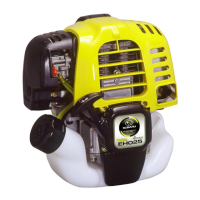
Do you have a question about the Robin EHO25 and is the answer not in the manual?
Definition of maximum engine output under broken-in conditions.
Definition of continuous rated engine output for engine longevity.
Defines maximum torque and fuel consumption rate.
Graphical representation of engine performance characteristics.
Highlights the engine's compact and lightweight design features.
Explains tilted operation capability for applications like brush cutting.
Details construction of the cylinder block and crankcase.
Description of the crankshaft and connecting rod assembly.
Information on piston material and wear resistance measures.
Details on piston ring types and oil consumption reduction.
Description of the cam gear assembly and its materials.
Explanation of the forced air-cooled system.
Explanation of the engine's lubrication system operation.
Details of the T.I.C. flywheel magneto ignition system.
Description of the diaphragm type carburetor.
Information on the urethane foam air cleaner element.
Explanation of the decompression system for easy starting.
Diagram showing the engine's sectional view and components.
Tips and preparations for engine disassembly and reassembly.
Lists special tools required specifically for the EH025 model.
Step-by-step procedures for disassembling the engine.
General guidelines and precautions for engine reassembly.
Reassembly of the cylinder block, valve spring, and retainer.
Reassembly of the connecting rod, piston, and piston rings.
Reassembly procedure for the cylinder block and crankcase.
Reassembly steps for the oil case and related components.
Instructions for correctly installing the flywheel.
Instructions for installing the ignition coil and adjusting air gap.
Instructions for installing the blower housing.
Instructions for correctly installing the cam gear.
Reassembly of the push rod, cam lifter, and rocker arm.
Instructions for installing the camgear cover.
Procedure for adjusting the valve clearance.
Instructions for installing the rocker cover.
Installation of the pulley, fuel tank, and recoil starter.
Installation of the muffler and its gasket.
Installation of the insulator and insulator carburetor assembly.
Assembly of carburetor and air cleaner components.
Instructions for installing the spark plug.
Instructions for installing the clutch assembly.
Installation of the engine cover, stop switch, and plug cover.
Procedure for filling engine oil and checking the oil gauge.
Description of the T.I.C. flywheel magneto ignition system.
Troubleshooting steps for magneto failure and spark checking.
Explanation of the automatic decompression system's function and mechanism.
Inspection procedures for the automatic decompression system assembly.
Explanation of the diaphragm carburetor's operation and construction.
Detailed functions and construction of the diaphragm system.
Procedures for disassembling and reassembling the carburetor.
Precautions to follow before carburetor disassembly.
Step-by-step procedures for carburetor disassembly and reassembly.
Precautions for inspecting carburetor components.
Explanation of the marks stamped on the carburetor.
Step-by-step guide to disassembling the recoil starter.
Step-by-step guide to reassembling the recoil starter.
Checks to perform after recoil starter reassembly.
Additional guidance for recoil starter maintenance and troubleshooting.
Checks for lack of spark in the ignition system.
Common causes and checks for engine misfires.
Reasons and checks for the engine stopping unexpectedly.
Causes and solutions for engine overheating.
Causes and solutions for engine knocking.
Reasons for engine backfiring through the carburetor.
General guidelines and considerations for mounting the engine.
Importance of proper ventilation for engine cooling and operation.
Guidelines for safe and effective exhaust gas discharge.
Methods for transmitting power to driven machines, e.g., belt drive.
Standard and limit values for various engine component clearances.
Recommended torque values for tightening engine components.
Guide for selecting appropriate engine oil grades based on temperature.
Routine maintenance checks recommended for daily operation.
Initial maintenance tasks required after 20 hours of operation.
Maintenance schedule for every 50 hours or 10 days of use.
Periodic maintenance tasks required every 100-200 hours or monthly.
Procedures for storing the engine properly for extended periods.